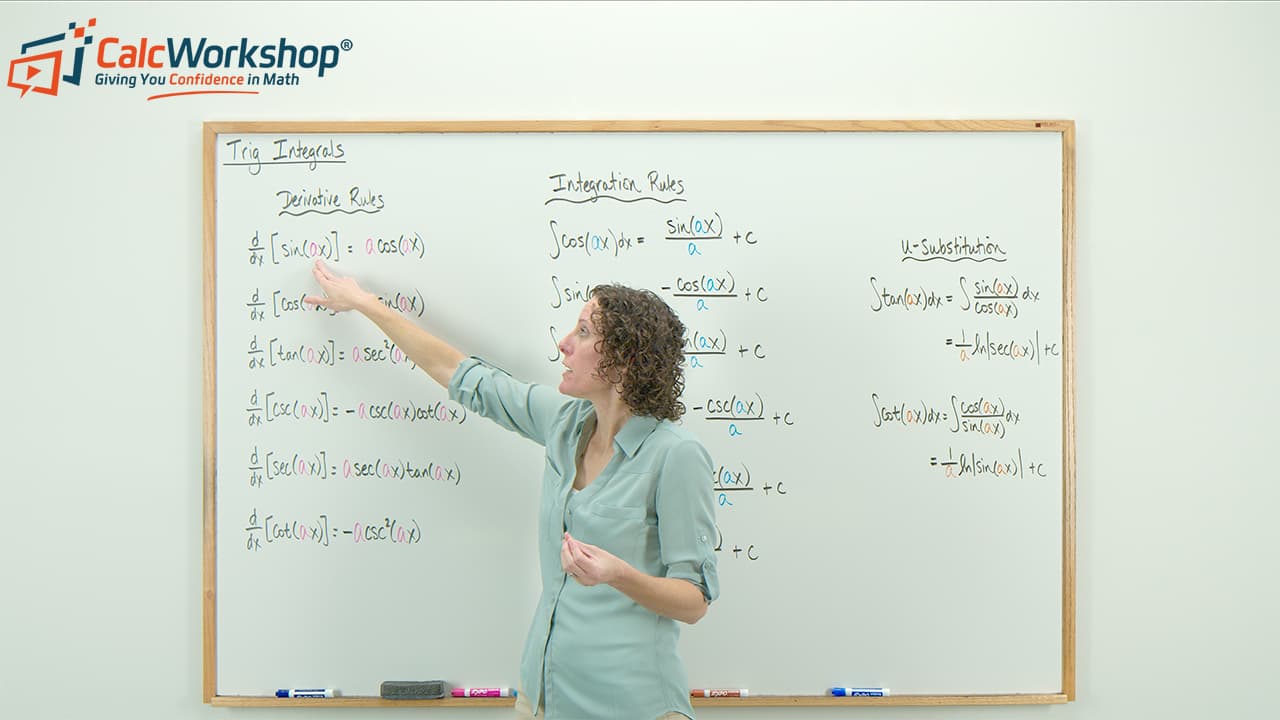Have you ever wondered how to integrate trigonometric functions, also known as Trig Integrals? Imagine you’re trying to put together a jigsaw puzzle: you’ve got all the pieces (the trigonometric functions) but need to find the right way to connect them (the integration process).

Jenn, Founder Calcworkshop®, 15+ Years Experience (Licensed & Certified Teacher)
We’ll cover the essential integration formulas for trigonometric functions, work through examples of integrating both indefinite and definite integrals, and demonstrate how to apply trigonometric identities to simplify your solutions.
So, let’s go!
Understanding Trig Functions and Their Layers
Every trigonometric function has two parts or layers:
- Trig
- Angle
But what’s most fascinating about trigonometric functions is that these two parts or layers play a special role in how we differentiate and integrate trigonometric functions.
Let’s take a look.
Trigonometric Integration Formulas
Well, when we take the derivative of a trigonometric function, we apply our differentiation rule to the “trig” part and then multiply by the derivative of the “angle” layer.
But when we take the antiderivative of the trigonometric function, we apply our integration rule to the “trig” part and then divide by the coefficient of the “angle” layer.
Comparing Derivatives and Integrals of Trig Functions
When we compare the derivative and the integral for a trigonometric function side-by-side we see some pretty amazing things.
Look at how the integral simply takes the answer from the derivative and returns the original function.
This means that as long as we know our derivative rules, we also know our integration rules for trig functions too! The only difference is that for integration we do the inverse and divide by the coefficient on the angle rather than multiply!
Sweet!
Now, it must be noted that the coefficient of the angle must be a constant and the variable must be linear (i.e., to the power of 1) in order for us to use these formulas. If the coefficient is something other than a constant (number) or if the variable is nonlinear, then we will have to utilize more advanced integration techniques, which we will learn about in future lessons.
Let’s look at a few examples to get the hang of things.
Integration Example: Sinusoidal Function
Evaluate
All we have to do is identify the pieces of the integrand and match them to our formula:
Integration Example: Difference of Trig Functions
Evaluate
First, let’s split the two terms into two separate integrals, so it will be easier to identify the formula we will need to use.
Now, let’s identify the pieces of the integrand and match them to our formula:
Pretty straightforward, right?
What is so important to remember, as Interactive Mathematics accurately states, we are going to use our knowledge of the derivatives and reverse the differentiation processes.
Awesome!
In this lesson, you will:
- Work through numerous examples of integrating both indefinite and definite integrals involving trigonometric functions
- Utilize trigonometric identities, especially the Pythagorean Identities, to aid in simplifying integrands and solutions
Let’s jump right in!
Video Tutorial w/ Full Lesson & Detailed Examples

Get access to all the courses and over 450 HD videos with your subscription
Monthly and Yearly Plans Available
Still wondering if CalcWorkshop is right for you?
Take a Tour and find out how a membership can take the struggle out of learning math.